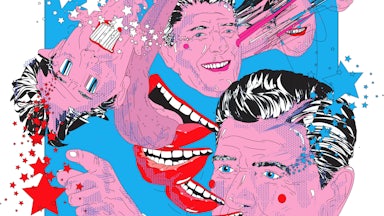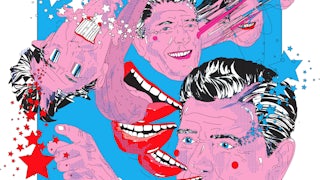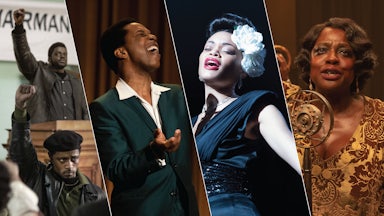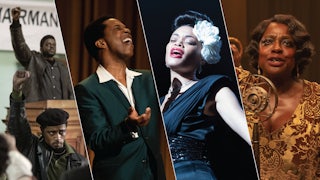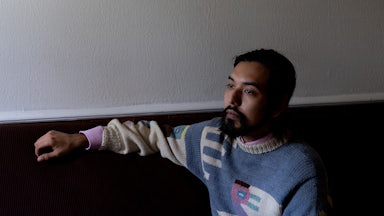For the American left of the 1960s and early 1970s, the past refuses to stay past. Two of the most popular films nominated for Best Picture this year—Shaka King’s Judas and the Black Messiah and Aaron Sorkin’s The Trial of the Chicago 7—daubed the radicals of that era in seductively heroic hues. Reports of last summer’s massive protests against police killings of African Americans often evoked the civil rights and Black Power movements led by figures such as Martin Luther King Jr., Stokely Carmichael, and Angela Davis. Unknowingly or not, contemporary critics and defenders of wokeness are recapitulating the old arguments about political correctness that first erupted during the Nixon presidency. And the recent meteoric growth of Democratic Socialists of America—now approaching 100,000 members—was last matched on the left by Students for a Democratic Society, the mostly white group of similar size that boomed with the escalation of the Vietnam War and then imploded into warring sects before the decade ended.

Yet, persistent memories are not evidence of enduring success. The fundamental question to ask about the New Left, in whole or in fragments, is the same one that should be posed about any social movement: So what? Did the actions of radicals transform the nation in any fundamental way? Or did they blaze too quickly across the landscape, drawing more than their share of media attention while provoking the anger of “Middle Americans” who responded by electing the likes of Richard Nixon and Ronald Reagan to run the country? How should we balance the accomplishments of the New Left with its failure to build a sturdy rival to the cautious liberals and confident neoliberals who have dominated the past half-century of U.S. politics and governance?
David Talbot and Margaret Talbot, siblings and veteran journalists, have crafted a book of personal narratives rich with the kinds of details that might help answer such queries. Beginning with the activist-celebrity couple Tom Hayden (an SDS founder) and Jane Fonda, the Talbots move briskly to chronicle the lives, loves, and occasional second thoughts of leading figures in the Black Panther Party, the women’s liberation movement, the California farmworkers’ union, the gay rights movement, and the American Indian Movement. John Lennon and Yoko Ono get their own chapter, too, illuminating how, after the Beatles’ breakup, the duo promoted left-wing causes with their words, music—and oodles of cash.
The book brims with vivid descriptions of how all these characters looked, dressed, got along with one another (or didn’t), and how they came across in public. The Talbots sprinkle in factual nuggets that might surprise even former activists from those years or the historians who write about them (this reviewer belongs to both clusters). I did not know Aretha Franklin and Lennon and Ono performed at the same 1971 concert in Harlem to benefit the families of prisoners murdered during the iconic uprising at Attica prison. Nor had I heard that Craig Rodwell got the idea of opening the first openly gay bookstore in Greenwich Village from the Christian Science reading rooms he had frequented in his childhood—or that he refused to sell porn magazines in his shop because he believed their publishers exploited the people photographed in their pages.
Nothing in these portraits, however, backs up the notion of a “second American revolution” in the book’s subtitle. Talk of “revolution” was as common in the 1960s left as raised fists, civil disobedience, and roach clips. But few of the radicals who yearned for it had a clear idea of how they might overthrow the political system or the circumstances that would make that possible. As a social democrat, I am not in the habit of quoting Lenin. But the old Bolshevik was on the mark when he wrote, in 1915, that revolutionary situations emerge only when the people refuse to live in the old way and the ruling elite is unable to rule in the old way. In the United States some 50 years ago, neither condition came remotely close to occurring. In fact, it was the right, not the left, that emerged from the long 1960s far stronger than when the era began.
The burning dreams of the Talbots’ title, on the other hand, are what the young radicals did leave behind. While their revolutionary dreams turned to ashes, their egalitarian ambitions inspired some to launch more practical endeavors, whose consequences, as the philosopher Richard Rorty wrote back in 1998, helped “decrease the amount of sadism in our society.” The stories the Talbots tell reveal that some prominent leftists learned from their mistakes, if not their tragedies, while others kept believing, to their peril, in a revolution that was never going to happen.
One can draw both these lessons from the short, floodlit history of the group christened the Black Panther Party for Self-Defense in 1966. Its creators, Huey Newton and Bobby Seale, first recruited members by arming themselves to confront Oakland police who sought to arrest local residents, often brutally, for no good reason. Subsequent battles with police, there and elsewhere, turned survivors, the charismatic Newton most famously, into potent symbols of resistance to a brutal carceral state. The “Black Messiah” of the acclaimed recent film was Fred Hampton, leader of the Chicago chapter, whom Chicago police gunned down in his bed early one December morning in 1969. He was just 21 years old.
As the Talbots write, “firearms assume their own inevitable logic in political life.” Leftists of every race lauded the Panthers’ eagerness to “pick up the gun” as a daring break with the nonviolent movement’s long slog to pass legal reforms that seemed to leave Black people scarcely better off than before. They were not the only radicals at the time who thought violent acts could advance their mission. A bombing campaign by the Weather Underground kept the FBI busy through the 1970s but never resembled the “white fighting force” the former SDS activists vowed would back up wars by rebels of color both in the United States and abroad. More successful were the activists in the American Indian Movement, who engaged in a 1973 battle with federal agents on a South Dakota reservation over the ousting of a corrupt tribal leader. Their monthslong occupation of the town of Wounded Knee, and the taking of 11 hostages, got their cause a national hearing and a rush of sympathy for the plight of the continent’s first inhabitants. The Talbots report that an opinion poll took the side of the Native warriors.
The BPP’s militancy helped spur emulators like the Young Lords Party among Puerto Ricans in Eastern cities and the Brown Berets among Mexican Americans in Southern California. In nations from India to Britain to Israel, activists from ethnic minorities adopted the Panther name as a kind of shorthand for militant opposition to the discrimination they suffered. Alas, Newton’s 1973 book Revolutionary Suicide provided an apt, if unintentional, description of how the BPP expired back home. The free breakfast and health programs that the Panthers sponsored in Black communities did not survive the group’s bitter internal divisions or Newton’s own descent into megalomania and cocaine addiction, before he was murdered by a drug dealer in 1989.
The renown of young African Americans willing to risk their lives to free their people also helped catalyze worthy initiatives by supporters who had no taste for martyrdom. In colleges around the nation, departments of and courses in Black and ethnic studies sprouted, giving intellectual depth to the brand of radical nationalism the Panthers championed. Although Bobby Seale lost his race for mayor of Oakland in 1973, his candidacy pioneered the way for other leftists to get elected to office in districts, towns, and cities with Black majorities. Since the early 1990s, Bobby Rush, who co-founded the Illinois chapter of the BPP, has represented the South Side of Chicago in Congress as a reliable progressive, if one who avoids discord with Democratic leaders. The political gains and limits of Black Power are encapsulated in the contrast between Rush’s long, if undramatic, career, and the inspirational yet violent life of Huey Newton, leader of the party that flamed out less than a decade after its birth.
In chapters on radical feminists and gay rights activists, the Talbots choose to write about groups that did not let revolutionary rhetoric get in the way of building new institutions and defying bad laws. Outlasting the eruptions of the 1960s, these groups kept growing into the 1970s and beyond. The Talbots devote most of one chapter to the Jane Collective, which arranged and performed abortions in Chicago at a time when the procedure “was fully legal in just four states in the country.” The Janes educated themselves about obstetrics and gynecology and became adept at counseling women who needed their help. Some got busted but stayed out of jail long enough to celebrate the Roe v. Wade decision that essentially voided their convictions.
A central figure in that courageous group was Heather Booth, a young Jewish woman from a middle-class suburb who began her activist life in Mississippi in 1964, registering Black voters and teaching in Freedom Schools. She remains an effective and beloved organizer for left causes, almost six decades later. Vital to that endurance is the kind of empathy she learned to practice in the ’60s. Of her peers, the Talbots write, “They wanted to build a radical movement that would encourage people to change their lives.” But, quoting a comrade of Booth’s, they observe it had to be one that would “steer a generous course away from denouncing women for the choices they made in their efforts to get through the day.”
Some violent disruptions could encourage people, long accustomed to accepting mistreatment from on high, to rise up. That was the case for the Panthers, who started to patrol the Oakland streets, loaded rifles in hand. The patrons of the Stonewall Inn in Lower Manhattan did not plan to resist the police raid on the bar in June 1969, but their confrontation quickly turned into as crystallizing an event for their burgeoning movement as the Montgomery Bus Boycott of the mid-1950s was for the civil rights crusade. And who could not delight in hearing that some of the queens that night sang, “‘We are the Stonewall girls / we wear our hair in curls / we wear no underwear / we show our pubic hair’ to the tune of the Howdy Doody song” as they dashed away from the cops? But after Stonewall, activists largely picked up megaphones, picket signs, and lawbooks instead of fighting the cops. Over the next decades, they lobbied to pass anti-discrimination statutes, rallied to demand funding for victims of aids and speedy approval of drugs to combat the disease, and fought through state and federal courts to make marriage equality the law of the land.
No one can accuse the Talbots of neglecting the fierce, diverse identities that composed and animated the ’60s left. They devote equal space to Native American rebels like Russell Means and Dennis Banks, Black leaders like Seale and Newton, the Chicano unionist Cesar Chavez, the white antiwar activists Hayden and Fonda, feminists like Booth, and gay liberationists like Rodwell. They also describe how inequalities of race and gender—and fame—often kept like-minded rebels from accomplishing more.
The big piece nearly absent from their mosaic is one that radicals themselves largely neglected at the time: the injuries of class. John Lennon is the only major character in the book who makes an explicit reference to a kind of economic inequality, and it comes in his song “Working Class Hero,” which inspired no protest marches and launched no organization. The Talbots’ chapter about the United Farm Workers (UFW) focuses on Chavez himself, the former migrant worker who led the national grape boycott that began in 1965. Three years later, it gained the passionate backing of Robert Kennedy during his campaign for president.
But La Causa that both liberals and radicals embraced never matured into a sizable or powerful union. Most farmworkers in California and elsewhere continue to be among the worst paid, with perhaps the most precarious jobs in the nation. What the authors call Chavez’s “martyr complex” was part of the reason for the union’s collapse. He put himself through a series of lengthy fasts to promote the union cause and subsequent strikes. By the mid-’70s, when those acts of self-sacrifice did little to advance the struggle, he compelled members of the union’s executive board to participate in a manipulative “mind-control technique” developed in a recovery center for drug addicts in San Francisco. His goal was evidently to discipline the staff to follow his commands. But, according to the Talbots, “the exercise fed Chavez’s growing paranoia about conspiracies against his leadership.” Most of his old comrades deserted him, and the union declined from a peak of 80,000 members in 1973 to a mere 5,000 by his death in the early 1990s. Even during the UFW’s brief heyday, most on the left regarded it more as a civil rights crusade for Mexican Americans than as an opportunity to expand the labor movement to include the majority of wage earners who still lacked a union to represent them.
In retrospect, the absence of a language of class and of a strategy to organize wage earners across racial boundaries is understandable. The movement for Black freedom and the horror of the Vietnam War were what radicalized young Americans; at a time of general prosperity, few paid attention to the drudgery and indignity of labor suffered by millions who did not share their views about racism or military intervention. It did not help that the leaders of the AFL-CIO, anti-Communists to a man, strongly endorsed the war in Southeast Asia. Those on the left who did routinely employ terms like “the working class” and “capitalism” tended to do so in dogmatic ways for sectarian purposes. Most New Leftists shunned them.
So, when radicals chanted “Power to the People” (a slogan coined by the Black Panthers but adopted by activists of many stripes), they did not really mean a majority of them. After all, most Americans at the time either had turned cynical about politics or favored using power to do things leftists abhorred. Half a century later, a broad coalition that would represent working people of all races remains to be built, by progressives inside and outside the Democratic Party. The leftists of half a century ago never really tried; their successors must and can.

